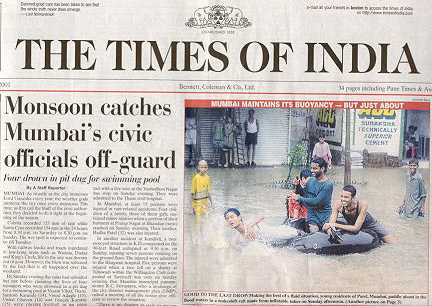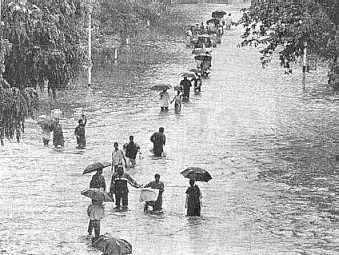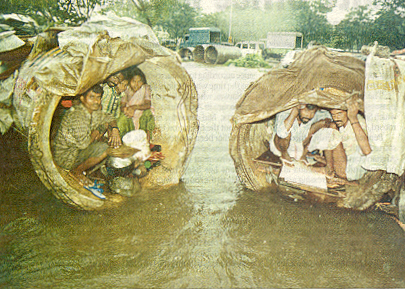


Reuters
Islamabad, July 24
AT LEAST 103 people were killed and many injured by flash floods caused by heavy rains in northern Pakistan on Monday, police and other officials said.
Sixty-two people were killed and more than 100 injured when a flash flood washed away a small hillside village in Manshera district in the North West Frontier Province, officials in the region said. Five more people were killed in a nearby village.
Officials in the Buner district in the Swat valley said 14 members of one family were killed by lightning in Batwani village. Six people were washed away in the nearby Chagharzai village and five others died in house collapses.
In Islamabad, three people were killed and several injured by collapsing walls and electrocution during record rainfall of more than 620 mm (24 inches). Eight people died in the adjoining Rawalpindi city, where civil defence officials said several houses collapsed.
Heavy rains have fallen across much of northern Pakistan since Sunday night and local weather officials forecast more rain later in the night.
An official at the deputy commissioner's office in Manshera said by telephone that about 25 houses in the village of Dadar were washed away by the flash flood early in the morning.
"We are still trying to recover people from the debris and those who have been swept away in the nearby river," the official said, referring to the Siran river.
State-run Radio Pakistan said at least nine people were missing and rescue agencies were trying to find them. The village, in an area prone to landslides, is 95 km north of Islamabad, near the small town of Shinkiari on the famous Karakoram Highway. Police quoted witnesses as saying a bolt of lightning hit the ground, causing flood water to pour out.
Weather officials said the capital Islamabad received 621 mm (24.5 inches) of rain in 10 hours up to 4 pm, when it eased to a drizzle, but more rain was expected overnight.
The deluge brought the city to a standstill but the water later receded, allowing traffic to resume. The previous record was in August 1997, when 320 mm (13 inches) of rain fell in 24 hours. The met office had this month predicted more than normal rainfall this monsoon season.
Weather officials said they warned civil and military rescue agencies to be on alert for flash floods, particularly in the adjoining city of Rawalpindi, where 170 mm (6.7 inches) of rain fell.
The radio said the Pakistani army was using boats to evacuate people from the low-lying areas of Rawalpindi.
FLOOD situation worsens in Orissa
KENDRAPARA: Torrents of water released from a dam charged into flooded coastal areas of eastern India on Friday, adding another 200,000 people to the tally of six million hit by the disaster.
Army boats joined civilian rescuers in Orissa as the floods, which have claimed 39 lives and left more than a million marooned, spread like a giant lake across the land.
Officials said the floods -- triggered by unusually heavy monsoon season rains in Orissa and neighbouring, upstream states -- have washed away 4,000 houses and damaged 18,000 homes in the same low-lying are that was savaged by a cyclone two years ago.
"We are still on tenterhooks as there has been rain in the catchment area of the Mahanadi in Jharkhand state," said District Collector of Kendrapara K C Mohanty.
"We have already got the army's help and we will be getting a boat from the navy," he told Reuters.
The town of Kendrapara lies 80 km northeast of the state capital, Bhubaneshwar. Mohanty said almost half of the 1.3 million people living in the town and its district had been affected by the flooding over the last week.
Close to 200 villages and 181,000 people were sucked into the calamity overnight as water which had to be released from the swollen Hirakud dam gushed through Kendrapara, causing eight breaches in two tributaries of the Mahanadi.
"The water outflow from the Hirakud dam is slightly less than yesterday when 33 gates were open. Today 27 gates are open. The concern is about the low-lying areas of Kendrapara and Jagatsinghpur when the water from the dam passes through," said B.B. Mahapatra, joint secretar of the Orissa government.
"WE ARE READY TO SLEEP ON ROOFTOPS"
Officials and local residents battled side by side in Kendrapara to reinforce crumbling embankments.
"We did not sleep all night. We kept putting sandbags at places wherethe water was breaking through or flowing over the embankment," said Narayan Chakraborty, a shopkeeper.
His shop, which lies a stone's throw from a raging tributary of the Mahanadi, is empty as he has moved all his goods to his house at a safe distance from the river.
"We are ready to sleep on the rooftops if need be," he said. The army worked non-stop with rubber boats to pick up people trapped in the swirling and muddy river waters, and by Friday morning they had rescued 400 people.
"The problem is that the villagers leave their houses only at the last moment when the waters start flooding in. We really have to persuade them to leave earlier," said Major Sushil Kumar.
Monsoon rains in Orissa have been unusually heavy this year. The state received 820 mm of rain between June 1 and July 18, almost double the normal level for the period.
Special Relief Commissioner H K Panda told Reuters saidon Thursday night that more rain was forecast for the next two days.
"The state is facing a huge crisis. It will be the worst-ever flooding in the history of the state," he said.
Patrick Fuller, South Asia spokesman for the International Federatio of Red Cross and Red Crescent Societies, told Reuters the situation was set to worsen because high tides in the Bay of Bengal would slow the rivers emptying into the sea.
"This is like a real double blow for those who are just trying to pick up the pieces from 1999," Fuller added, referring to a "supercyclone" that slammed into the state, killing some 10,000 people.
Fuller said the local Red Cross was providing plastic sheeting for temporary shelter, dry food and water purification tablets, and all the coas clone shelters built after the 1999 calamity were in use.
( REUTERS )



AHMEDABAD: Eight more people were killed as heavy rains continued to lash several parts of Gujarat for the third consecutive day on Sunday, taking the monsoon toll to 28.
Two deaths each were reported in Amreli and Jamnagar districts and one each in Kaira, the Panchmahals, Porbander and Mehsana. Twenty deaths were reported on Saturday as torrential rain lashed Saurashtra and other parts of the state, excepting Central Gujarat where the monsoon activity is yet to pick up. More than 30 talukas of the Panchamhals, Dahod, Kaira and Sabarkantha have not yet received even 100 mm of rainfall.
According to official reports reaching
the revenue control room, Chotila and Dhrangadhra talukas of Surendranagar
district received the maximum rainfall in the state recording over 225
mm in the past 24 hours. Other talukas of Surendranagar district such as
Halvad, Lakhtar, Wadhvan, Sayla and Dasada received between 125 mm
and 161 mm of rainfall.
In North Gujarat, Bechraji, Patan,
Kadi, Mehsana received moderate to heavy rainfall, heralding a good monsoon
for farmers
after two consecutive years of
drought. In adjoining Ahmedabad district, Ranpur and Viramgam also received
more than 115 mm of rainfall.
The water level in dams, lying dry for the past several months, has increased in the past three days as heavy rains were reported from Junagadh, Amreli, Jamnagar and Bhavnagar districts in the past 24 hours. The monsoon activities have eased the drinking water crisis and fodder shortage in about 200 talukas, which were reeling under severe drought conditions.
Relief works director B R Patel told The Times of India' that of the 199 drought-affected talukas as many as 115 had received over 125 mm of rainfall in the past 48 hours. As a result, relief works in these talukas had been discontinued. However, the relief work schedule in Mandal, Sanand and Detroj would continue as the areas were yet to receive the required 125 mm rainfall.
A similar situation prevailed in
Palanpur, Vadgam, Dantiwada, Tharad and Vav talukas of Banaskantha district.
In Saurashtra,
barring a couple of talukas in
Amreli and Bhavnagar districts almost all talukas received more than 125
mm of rainfall.
In South Gujarat, Amod, Valia and
Hansot talukas of Bharuch district received almost 125 mm of rainfall.
HYDERABAD: The monsoon that brings rains to much of Asia is linked to the growth of the Himalayas and the Tibetan Plateau, according to new research published in Nature.
A major uplift of the plateau around 8-10 million years ago and a smaller one 3.6-2.6 million years ago phased in the monsoon, say climatologist John Kutzbach of the University of Madison, Wisconsim, and geologist colleagues from China and the United States.
The team has compared clues to Asia's climate over the past 10 million years with the record of tectonic growth-spurts in the region.
Today, the Tibetan Plateau, ringed by the Himalayas drives the monsoon winds that govern the continent's climate. Says Kutzbach, "in the summer, the plateau is like a burner on an overn sticking halfway up into the atmosphere. Warmed, the column of air above the plateau rises up, drawing in warm, wet air from the Indian Ocean and brining with it the summer monsoon rains."
In winter, the reverse is true.
The plateau, acting like a giant ice cube, cools the parched air above,
which rushes down off the
plateau towards the Indian Ocean,
the climatologist adds.
Until the plateau formed, the new study suggests, Asia's weather was far less diverse. It was probably uniformly warm and wet in the south, gradually changing to cool, dry climes in the north.
Ancient sediments from the Indian and Pacific Ocean and from China hint that monsoon winds intensified 8-10 million years ago and 3.6-2.6 million years ago, Kutzbach's team believes.
Fossils of single-celled marine organisms called "foraminiferans" reflect monsoon-driven changes of nutrients in the ancient ocean. The sizes of the wind-borne sediments from China reveal the strength of the winds over geological time.
The researchers checked their interpretation by feeding the Tibetan Plateau's growth into a climate model of the monsoon. Working back from the present day, they found that the monsoon weakened in a similar way to that implied by the sediment data.
"It goes away as you take the mountains
away," says Kutzback. (PTI)